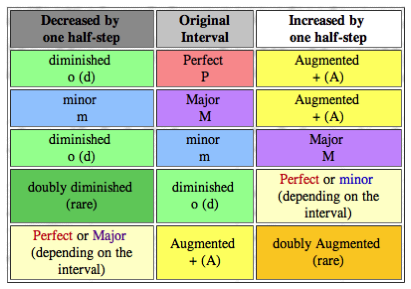| 10 |
Intervals |
| An interval in music is the distance in pitch between two notes. When the notes are performed simultaneously they are considered "harmonic" intervals. When they are performed successively they are considered "melodic" intervals. "Harmonic" intervals are thought of as vertical sonorities, while "melodic" intervals are thought of as horizontal or linear relationships. Intervals are generally categorized by two concepts: distance and quality. Distance refers to the actual space between the two pitches. The simple "distance" designations are: Unisons; 2nds; 3rds; 4ths; 5ths; 6ths; 7ths; and Octaves (8ve) Intervals, related to the tonic pitch of a major scale, look like this: |
|||||
|
||||||
Quality refers to the specific type of relationship between the notes. The "qualitly" designations are: perfect (P); major (M); minor (m); augmented (A); and diminished (d) The designation "perfect" only refers to unisons, 4ths, 5ths, and 8ves. Usually, 2nds, 3rds, 6ths, and 7ths are designated "major" or "minor" Note the quality of the intervals based on the major scale (C Major). |
|||||
|
||||||
| Take note of the M3, M6, and M7 in the major key. In the minor key (C minor), these intervals will be one half-step smaller, making them m3, m6, and m7. |
|||||
|
||||||
When the distance of a Major or Perfect interval is expanded by one half-step without changing the numerical name, the interval becomes Augmented. When the distance of a minor or Perfect interval is decreased by one half-step without changing the numerical name, the interval becomes diminished. The chart below demonstrates the relationships between the interval qualities. (smaller)<------<-------<------------>------>------>(larger) diminished<------>minor<------>Major<------>Augmented diminished<----------------Perfect--------------->Augmented One other interval that should be mentioned at this point is the A4 / d5. This interval is also referred to as the Tritone. It serves a significant purpose in functional, tonal harmony, which will be covered more fully at a later point. The following chart indicates how the quality of each type of interval is altered by half-step variations.  Any interval can be inverted by placing the upper pitch underneath the lower pitch. For example, when the interval C--G is inverted it becomes G--C. When intervals are inverted the distance relationships are as follows: 2nd inverts to 7th (7th inverts to 2nd) 3rd inverts to 6th (6th inverts to 3rd) 4th inverts to 5th (5th inverts to 4th) When intervals are inverted the quality relationships are as follows: m inverts to M (M inverts to m) A inverts to d (d inverts to A) P inverts to P Examples m2 inverts to M7 M3 inverts to m6 P4 inverts to P5 Click here to see Intervals on the Keyboard. Click here to see and hear Intervals on the Staff. |
|||||


